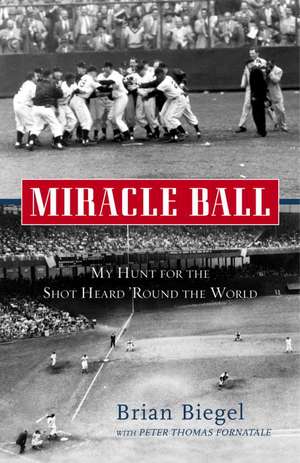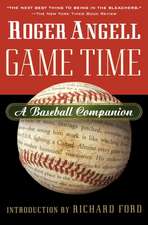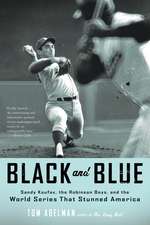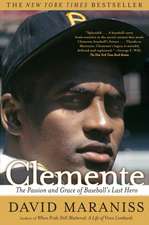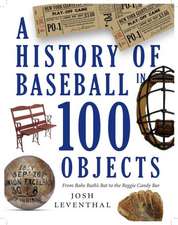Miracle Ball: My Hunt for the Shot Heard 'Round the World
Autor Brian Biegel, Pete Fornataleen Limba Engleză Paperback – 31 mai 2010
"A fast-paced, fascinating tale that combines shoe leather, high-tech forensics and some healthy dollops of luck….Biegel makes a compelling case that he's solved the mystery…his book is a home run." ߝ Associated Press
October 3, 1951. Giants third baseman Bobby Thomson hit the most dramatic home run in the history of baseball. The moment occurred in the bottom of the ninth inning of a sudden-death playoff game between the New York Giants and their arch rivals from Brooklyn, the Dodgers. People across the nation watched on their new TV sets, and the home run became known as “the Shot Heard ’Round the World.”
But after clearing the left-field wall, the central artifact of the play—the ball itself—inexplicably went missing. The mystery of what happened to the legendary baseball has remained unsolved for a half century.
Until now.
Miracle Ball is the gripping account of author Brian Biegel’s two-year effort to unravel the mystery that experts said could never be solved. A sports story for the ages, an engrossing mystery narrative, and a moving account of a man’s unbreakable bond with his family and of his struggles to save himself, Miracle Ball delivers both heart and headlines.
Preț: 110.06 lei
Nou
Puncte Express: 165
Preț estimativ în valută:
21.06€ • 22.52$ • 17.56£
21.06€ • 22.52$ • 17.56£
Carte tipărită la comandă
Livrare economică 17 aprilie-01 mai
Preluare comenzi: 021 569.72.76
Specificații
ISBN-13: 9780307452696
ISBN-10: 0307452697
Pagini: 231
Dimensiuni: 133 x 206 x 15 mm
Greutate: 0.2 kg
Editura: Three Rivers Press (CA)
ISBN-10: 0307452697
Pagini: 231
Dimensiuni: 133 x 206 x 15 mm
Greutate: 0.2 kg
Editura: Three Rivers Press (CA)
Notă biografică
BRIAN BIEGEL is an award-winning writer and filmmaker whose credits include Getting My Child Back: Fighting Autism and the documentary film version of this book similarly titled Miracle Ball: The Hunt for the Shot Heard Around the World. He has written and produced on-air promotions for ABC and USA networks and written and produced an Off-Broadway play called Bark Out Loud. He lives in Manhattan.
From the Hardcover edition.
From the Hardcover edition.
Extras
p r o l o g u e
“The Holy Grail of Sports”
Wednesday, October 3, 1951
The sun hung over the first-base side of the Polo Grounds, reflecting off the apartment buildings that lined Harlem River Drive and onto the open end of the stadium behind the left field stands. The clock in center field read 3:58. The details of the play itself are familiar to most baseball fans. Branca had Thomson down in the count 0-1, the result of a called strike right down the middle.
It was the bottom of the ninth. Two men on base. The Giants trailed the Dodgers by two runs in the last game of a three-game playoff series. The winner would advance to the World Series against the New York Yankees. Out of the windup, Branca threw a fastball, high and tight. But this time Thomson, the lanky outfi elder turned third baseman, was ready. He pulled the pitch to left field—a sinking line drive.
The fans in the lower portion of section 35 followed the flight of the ball. A photo captured the moment perfectly. There was an overweight, middle-aged man in a white T-shirt and a black jacket in the first row. Next to him was a buzz-cut teenager
with thick-rimmed eyeglasses. A row above them stood a man with a handlebar mustache and a fedora. In the fourth row, a bushy-haired man stood with his arms stretched above his head and his mouth wide open.
The crowd’s loyalties were evenly divided: The Dodgers fans prayed that the ball would somehow find its way into left fielder Andy Pafko’s mitt; the Giants fans prayed that it wouldn’t. The teams’ rivalry—the oldest in professional sports—dated back all the way to the nineteenth century, but it had never seen a moment like this.
The prayers of the home team’s fans were answered: Thomson had hit a home run; the Giants won the pennant. Thomson’s blast became known as the Shot Heard ’Round the World. As for the baseball itself, that’s been a mystery ever since. Just after the ball cleared the wall, it bounced out of a fan’s glove and ricocheted seven feet to the left—straight into the hands of a person who would ensure that its fate would not be discovered for more than fifty years.
It is the most iconic moment in the history of American sports—Bobby Thomson’s game-winning home run to clinch
the 1951 pennant for the Giants at the Polo Grounds. It’s been mythologized by everyone from sportswriters and broadcasters to literary giants like John Steinbeck, Jack Kerouac, and Don DeLillo. There have been equally dramatic home runs, but none have had the lasting cultural impact of the Shot Heard ’Round the World.
But as obsessively documented and frequently relived as that moment was, something happened that day that remains a mystery. As Bobby Thomson rounded the bases and broadcaster Russ Hodges so memorably shouted, “The Giants win the pennant! The Giants win the pennant!” the central artifact of the play—the ball itself—landed in the left-field seats and then . . . vanished.
While much has been written and said about the Thomson home run and its impact, remarkably little is known about what happened to the actual ball. It is one of sport’s greatest mysteries. Legendary sportswriter Vic Ziegel has called the Thomson ball “the Holy Grail of sports.” Over the past fifty years, several people have claimed to own it (often motivated by an exploding memorabilia market that has seen other well-known home-run balls fetch millions of dol-
lars at auction), but all of their claims have been disproved. The president of one prestigious auction house has estimated the odds of locating the ball at an astronomical 1 in 200 million. Similarly, every baseball historian I spoke with told me that there was no way to learn what really happened to it.
Fortunately for me, they were wrong.
This is the story of my two-year quest to solve the mystery that was supposed to be unsolvable. Several years ago, my father realized that he might have the famous missing baseball, and what began as a way to help my dad became, frankly, an obsessive hunt. It’s a journey that brought me from an auction house on Long Island to
the National Baseball Hall of Fame in Cooperstown, New York, to Bobby Thomson’s ranch-style home in New Jersey, to a forensics lab in Northern Long Island, to a dusty oil field in Texas, and ultimately to a spot on a quiet graveled road in New Mexico that was just about the last place I ever expected to be.
What kept me going was not simply the desire to unravel this legendary sports mystery. Like life itself, my search became all about the journey. Along the way, I met an incredible cast of characters: a celebrated sportswriter who has made a career out of writing about the Thomson ball; a crazed Dodgers fan who slept inside the Polo Grounds the night before the game; a retired NYPD detective who found an important clue hidden (in plain sight) in an old photo; a
baseball fanatic whose uncanny memory provided a crucial piece of the puzzle; two men from New Jersey who shared a seemingly astounding tale that turned out to fi t precisely with the other evidence; and many others.
It had been more than half a century since Thomson’s home run clinched the 1951 National League pennant, but everywhere I turned, it seemed as if there was another person telling a passionate story about the home run, or another eminent author or director who used it as a backdrop in his work. The response became overwhelming
when the New York Daily News ran a story on my search (in fact, it was one of the longest non-news features in the history of the paper).
Despite being a lifelong baseball fan, only in exploring this mystery did I come to fully appreciate what that game, and what those two teams, meant to baseball fans, and to New Yorkers of that era. As people told their stories, I began to understand why grown men cried in public over the game’s outcome; why schoolchildren schemed to follow the contest during their classes; why a young deli worker—now the own er of the New York Mets—was so startled by
Thomson’s home run against his beloved Dodgers that he sliced off a piece of his pinkie fi nger while making a salami sandwich; why a Marine in a bunker in Korea, a die-hard Giants fan surreptitiously listening to the game on Armed Forces Radio, became so excited when he heard Russ Hodges’s call that he accidentally shot off his rifle, spurring a fire fight with the enemy; and why a little boy watching the home run on TV felt so inspired by the miracle that something was born inside him—his faith in God. He later became a renowned monsignor in the Catholic Church and team chaplain of the New York Jets. Bobby Thomson’s moment was the stuff of flashbulb memories for millions.
And for me, the quest became deeply personal as well. It was from my father, who grew up a short distance from Ebbets Field in Brooklyn, that I inherited my love of baseball; it was for my father that I set out on this mission, as I attempted to determine whether his ball really was the Shot Heard ’Round the World; and it was my father and mother whose unwavering encouragement gave me the strength and confidence I needed to persevere during the darkest
period of my life.
Recovering from a bitter divorce and struggling with crippling depression and anxiety, I saw in the Thomson ball a way out, a way to regain my old sense of self. But depression is a powerful opponent and not one I was able to defeat on my own. What spurred me on was the love and unconditional support my parents showed me. As it turned out, this pursuit was the best kind of therapy I could ever want: Set a goal for yourself and work toward it—and refuse to be told you can’t do it. I have come to believe that this mission saved my life.
And for all the amazing things that happened during the search—the series of exceedingly unlikely twists of fate that brought me to my goal, the joy I saw in my mom’s face as I got closer to the truth, the opportunity to bring closure to my dad’s million-dollar dream, and the long-buried secret that lay at the end of the trail—I have come to regard this famous piece of cowhide as a miracle ball.
“The Holy Grail of Sports”
Wednesday, October 3, 1951
The sun hung over the first-base side of the Polo Grounds, reflecting off the apartment buildings that lined Harlem River Drive and onto the open end of the stadium behind the left field stands. The clock in center field read 3:58. The details of the play itself are familiar to most baseball fans. Branca had Thomson down in the count 0-1, the result of a called strike right down the middle.
It was the bottom of the ninth. Two men on base. The Giants trailed the Dodgers by two runs in the last game of a three-game playoff series. The winner would advance to the World Series against the New York Yankees. Out of the windup, Branca threw a fastball, high and tight. But this time Thomson, the lanky outfi elder turned third baseman, was ready. He pulled the pitch to left field—a sinking line drive.
The fans in the lower portion of section 35 followed the flight of the ball. A photo captured the moment perfectly. There was an overweight, middle-aged man in a white T-shirt and a black jacket in the first row. Next to him was a buzz-cut teenager
with thick-rimmed eyeglasses. A row above them stood a man with a handlebar mustache and a fedora. In the fourth row, a bushy-haired man stood with his arms stretched above his head and his mouth wide open.
The crowd’s loyalties were evenly divided: The Dodgers fans prayed that the ball would somehow find its way into left fielder Andy Pafko’s mitt; the Giants fans prayed that it wouldn’t. The teams’ rivalry—the oldest in professional sports—dated back all the way to the nineteenth century, but it had never seen a moment like this.
The prayers of the home team’s fans were answered: Thomson had hit a home run; the Giants won the pennant. Thomson’s blast became known as the Shot Heard ’Round the World. As for the baseball itself, that’s been a mystery ever since. Just after the ball cleared the wall, it bounced out of a fan’s glove and ricocheted seven feet to the left—straight into the hands of a person who would ensure that its fate would not be discovered for more than fifty years.
It is the most iconic moment in the history of American sports—Bobby Thomson’s game-winning home run to clinch
the 1951 pennant for the Giants at the Polo Grounds. It’s been mythologized by everyone from sportswriters and broadcasters to literary giants like John Steinbeck, Jack Kerouac, and Don DeLillo. There have been equally dramatic home runs, but none have had the lasting cultural impact of the Shot Heard ’Round the World.
But as obsessively documented and frequently relived as that moment was, something happened that day that remains a mystery. As Bobby Thomson rounded the bases and broadcaster Russ Hodges so memorably shouted, “The Giants win the pennant! The Giants win the pennant!” the central artifact of the play—the ball itself—landed in the left-field seats and then . . . vanished.
While much has been written and said about the Thomson home run and its impact, remarkably little is known about what happened to the actual ball. It is one of sport’s greatest mysteries. Legendary sportswriter Vic Ziegel has called the Thomson ball “the Holy Grail of sports.” Over the past fifty years, several people have claimed to own it (often motivated by an exploding memorabilia market that has seen other well-known home-run balls fetch millions of dol-
lars at auction), but all of their claims have been disproved. The president of one prestigious auction house has estimated the odds of locating the ball at an astronomical 1 in 200 million. Similarly, every baseball historian I spoke with told me that there was no way to learn what really happened to it.
Fortunately for me, they were wrong.
This is the story of my two-year quest to solve the mystery that was supposed to be unsolvable. Several years ago, my father realized that he might have the famous missing baseball, and what began as a way to help my dad became, frankly, an obsessive hunt. It’s a journey that brought me from an auction house on Long Island to
the National Baseball Hall of Fame in Cooperstown, New York, to Bobby Thomson’s ranch-style home in New Jersey, to a forensics lab in Northern Long Island, to a dusty oil field in Texas, and ultimately to a spot on a quiet graveled road in New Mexico that was just about the last place I ever expected to be.
What kept me going was not simply the desire to unravel this legendary sports mystery. Like life itself, my search became all about the journey. Along the way, I met an incredible cast of characters: a celebrated sportswriter who has made a career out of writing about the Thomson ball; a crazed Dodgers fan who slept inside the Polo Grounds the night before the game; a retired NYPD detective who found an important clue hidden (in plain sight) in an old photo; a
baseball fanatic whose uncanny memory provided a crucial piece of the puzzle; two men from New Jersey who shared a seemingly astounding tale that turned out to fi t precisely with the other evidence; and many others.
It had been more than half a century since Thomson’s home run clinched the 1951 National League pennant, but everywhere I turned, it seemed as if there was another person telling a passionate story about the home run, or another eminent author or director who used it as a backdrop in his work. The response became overwhelming
when the New York Daily News ran a story on my search (in fact, it was one of the longest non-news features in the history of the paper).
Despite being a lifelong baseball fan, only in exploring this mystery did I come to fully appreciate what that game, and what those two teams, meant to baseball fans, and to New Yorkers of that era. As people told their stories, I began to understand why grown men cried in public over the game’s outcome; why schoolchildren schemed to follow the contest during their classes; why a young deli worker—now the own er of the New York Mets—was so startled by
Thomson’s home run against his beloved Dodgers that he sliced off a piece of his pinkie fi nger while making a salami sandwich; why a Marine in a bunker in Korea, a die-hard Giants fan surreptitiously listening to the game on Armed Forces Radio, became so excited when he heard Russ Hodges’s call that he accidentally shot off his rifle, spurring a fire fight with the enemy; and why a little boy watching the home run on TV felt so inspired by the miracle that something was born inside him—his faith in God. He later became a renowned monsignor in the Catholic Church and team chaplain of the New York Jets. Bobby Thomson’s moment was the stuff of flashbulb memories for millions.
And for me, the quest became deeply personal as well. It was from my father, who grew up a short distance from Ebbets Field in Brooklyn, that I inherited my love of baseball; it was for my father that I set out on this mission, as I attempted to determine whether his ball really was the Shot Heard ’Round the World; and it was my father and mother whose unwavering encouragement gave me the strength and confidence I needed to persevere during the darkest
period of my life.
Recovering from a bitter divorce and struggling with crippling depression and anxiety, I saw in the Thomson ball a way out, a way to regain my old sense of self. But depression is a powerful opponent and not one I was able to defeat on my own. What spurred me on was the love and unconditional support my parents showed me. As it turned out, this pursuit was the best kind of therapy I could ever want: Set a goal for yourself and work toward it—and refuse to be told you can’t do it. I have come to believe that this mission saved my life.
And for all the amazing things that happened during the search—the series of exceedingly unlikely twists of fate that brought me to my goal, the joy I saw in my mom’s face as I got closer to the truth, the opportunity to bring closure to my dad’s million-dollar dream, and the long-buried secret that lay at the end of the trail—I have come to regard this famous piece of cowhide as a miracle ball.
